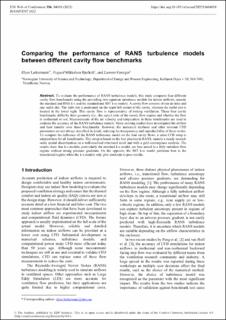| dc.contributor.author | Larkermani, Elyas | |
| dc.contributor.author | Bjerkeli, Vegard Mikkelsen | |
| dc.contributor.author | Georges, Laurent | |
| dc.date.accessioned | 2023-02-14T08:27:30Z | |
| dc.date.available | 2023-02-14T08:27:30Z | |
| dc.date.created | 2022-12-06T13:32:11Z | |
| dc.date.issued | 2022 | |
| dc.identifier.isbn | 9781713859420 | |
| dc.identifier.uri | https://hdl.handle.net/11250/3050555 | |
| dc.description.abstract | To evaluate the performance of RANS turbulence models, this study compares four different cavity flow benchmarks using the prevailing two-equation turbulence models for indoor airflows, namely the standard and RNG k-ε and the standard and SST k-ω models. A cavity flow consists of one air inlet and one outlet slot. The inlet slot is positioned on the upper left corner of the cavity, whereas the outlet slot is located in the lower right. This cavity flow is representative of mixing ventilation. These four cavity benchmarks differ by their geometry (i.e., the aspect ratio of the room), flow regime and whether the flow is isothermal or not. Measurements of the air velocity and temperature in these benchmarks are used to evaluate the accuracy of the RANS turbulence models. Many existing studies have investigated the airflow and heat transfer over these benchmarks. However, the numerical methods and other relevant CFD parameters are not always described in detail, reducing the transparency and reproducibility of these works. To compare the influence of the RANS turbulence model on the four cavity flows, a same CFD setup is adopted here for all benchmarks. This setup is based on the best practice in RANS, namely a steady second-order spatial discretization on a wall-resolved structured mesh and with a grid convergence analysis. The results show that k-ε models, particularly the standard k-ε model, are best suited in a fully turbulent flow regime without strong pressure gradients. On the opposite, the SST k-ω model performs best in the transitional regime while the k-ε models only give moderate to poor results. | en_US |
| dc.language.iso | eng | en_US |
| dc.publisher | EDP Sciences | en_US |
| dc.relation.ispartof | Proceedings ROOMVENT CONFERENCE. 16TH 2022. (ROOMVENT 2022) (2 PARTS) Item #:065443 Held 16-19 September 2022, Xi'an, China. | |
| dc.relation.uri | https://www.e3s-conferences.org/articles/e3sconf/abs/2022/23/e3sconf_roomvent2022_04010/e3sconf_roomvent2022_04010.html | |
| dc.rights | Navngivelse 4.0 Internasjonal | * |
| dc.rights.uri | http://creativecommons.org/licenses/by/4.0/deed.no | * |
| dc.title | Comparing the performance of RANS turbulence models between different cavity flow benchmarks | en_US |
| dc.title.alternative | Comparing the performance of RANS turbulence models between different cavity flow benchmarks | en_US |
| dc.type | Chapter | en_US |
| dc.description.version | publishedVersion | en_US |
| dc.subject.nsi | VDP::Teknologi: 500 | en_US |
| dc.subject.nsi | VDP::Technology: 500 | en_US |
| dc.identifier.doi | 10.1051/e3sconf/202235604010 | |
| dc.identifier.cristin | 2089425 | |
| cristin.ispublished | true | |
| cristin.fulltext | original | |
| cristin.qualitycode | 1 | |

